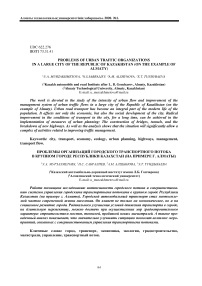Problems of urban traffic organizations in a large city of the Republic of Kazakhstan (on the example of Almaty)
Автор: Murzakhmetova U.A., Sabraliev N.S., Alshynova A.M., Tundybaeva E.T.
Журнал: Вестник Алматинского технологического университета @vestnik-atu
Рубрика: Экономика и сервис
Статья в выпуске: 1 (126), 2020 года.
Бесплатный доступ
The work is devoted to the study of the intensity of urban flow and improvement of the management system of urban traffic flows in a large city of the Republic of Kazakhstan (on the example of Almaty). Urban road transport has become an integral part of the modern life of the population. It affects not only the economic, but also the social development of the city. Radical improvement in the conditions of transport in the city, for a long time, can be achieved in the implementation of measures of urban planning: The construction of bridges, tunnels, and the breakdown of new highways. As well as the analysis shows that the situation will significantly allow a complex of activities related to improving traffic management.
City, transport, economy, ecology, urban planning, highways, management, transport flow
Короткий адрес: https://sciup.org/140250868
IDR: 140250868 | УДК: 622.276
Текст научной статьи Problems of urban traffic organizations in a large city of the Republic of Kazakhstan (on the example of Almaty)
Introduction: Prior to the appearance of a mass car, the decision of the city's layout was associated with the rational allocation of industry, recreation areas, the creation of a holistic architectural and planning composition of the city. These requirements are valid today, but they can only be met if the transport problems are solved. At present, specialists who have higher education in the field of traffic organization, road construction, engineering training of urban areas are becoming mandatory participants in the formation of a family planning at all its stages.
The interaction between the forest and the carriageway cover, overcoming the road hills, the movement along the curves in plan and the longitudinal profile of the catwalk are the same regularities. If the intensity of the traffic on the car is 500- 1000 autos/h is a rare exception observed on the roads of the first technical category, for urban streets, the technical parameters rarely exceed the parameters of the III technical category before the horns, such loading is usual. As a result, the problem of ensuring the capacity in the city is growing rapidly [1].
Currently, there are problems of road traffic organization in the major cities of Kazakhstan, especially in their central parts. This is due to the increase in the level of motorization and the presence of the historically established street-road network of the city, as well as the presence of parking on the roadway. All this leads to a decrease in the level of safety of vehicles and the capacity of the street-road network, which cause pre-congested traffic regimes.
Road traffic safety and the efficiency of traffic and pedestrian traffic management are largely determined by the quality of traffic organization, the reliability and fault tolerance of software and technical means of traffic control systems.
Road traffic safety and the efficiency of traffic and pedestrian traffic management are largely determined by the quality of traffic organization, the reliability and fault tolerance of software and technical means of traffic control systems.
Purpose of the study. The purpose of the work is to improve the management system of urban traffic flows in a large city of the Republic of Kazakhstan (on the example of Almaty)
Objects and methods of research. The object of the study is the loaded streets by motor vehicles on a high scale on the example of Abay Ave. and Rayymbek Ave. of Almaty. To carry out the study, an in-kind study is used, which allows to obtain actual characteristics in a given space and for a certain period of time, that is, the intensity of urban traffic in order to obtain and accumulate information on the total number of vehicles passing per unit time through this section of the road in both directions, as well as the composition of the traffic flow of automobiles.
The main part. Transport mobility of the population is one of the main indicators characterizing the transport system, and is an integral indicator reflecting a contradictory set of factors: The rhythm of the life of the region;
urban development features and planning structure; the state and development of transport infrastructure; economic aspects and others.
The level of transport discrimination of the population shows how much of the population of the region (in %) lives outside normative transport accessibility and is defined as the proportion of the population of those settlements whose accessibility to the service centers of the socially guaranteed minimum exceeds the norm by 10%.
Another important indicator of the level of transport discrimination of the population is closely related to the indicator of the level of transport discrimination of the population: The weighted average unavailability of services due to poor transport conditions. It shows how much time (beyond the estimated norms) an adult resident has to lose weekly to receive basic services in the region. According to the results of research, in the cities of Almaty and Astana, as well as in the regional centers of Kazakhstan, this indicator does not exceed 1 hour, while in rural areas it exceeds 10 hours.
Studies show that the critical level at which people refuse to consume services (even if financial opportunities exist) is: For everyday services – 1.5 hours, for episodic – 3.5 hours [2].
The main problem in the practice of managing the transport system in the cities of Kazakhstan today remains the problem of underfinancing the necessary elements of this system, ensuring the possibility of functioning and reproduction of the entire urban infrastructure. The extent to which this problem is acute depends directly on the distribution of managerial authority between the levels of government and their coordination with respect to the control of individual components of it. For example, the maintenance and construction of main roads financed by the state is in close connection with the support and reinstallation of access roads completely on the balance of local self-government bodies. The resulting imbalances are regulated by the urban authorities, forming part of their real authority.
The transport network is the most important source of urban processes, performing an important role in the realization of such funerals of urban life as industrial production, housing and trade enterprises. To date, studies in the field of optimization of transport communication in urban conditions have been carried out in the following directions [3]:
-
- determination of the need for spatial movements;
-
- determination of the dominant vectors of these movements;
-
- study of the priorities of citizens in the choice of mode of transport and
-
s ubstantiation of the general criteria of this choice;
-
- linking the movements of each mode of transport to the existing road network to determine the capacity of the territory.
The frequency of travel in the urban environment varies from city to city. The main factors influencing the size of the corresponding indicator are: The number of owners of motor vehicles, types of use of motor vehicles, the size (radius) of the city territory, the morphology of the city (its density, types of residential buildings), the composition of the population (ethnic, gender), the social and professional structure of the city.
Results and their discussion. A study of traffic characteristics is being carried out to obtain actual traffic data. Depending on the purpose of the study, different methods of determining the characteristics of road traffic can be used: Documentary, field and modeling [4].
At present, the most common field studies are the acquisition of actual characteristics in a given space and for a certain period of time. There are local, zonal and regional field studies used for various scales of such works.
Traffic intensity is determined by the number of actual vehicles that have passed the limits of the road object and the number of vehicles that have been delivered or calculated. These data are used for many engineering and economic tasks of road, road transport, traffic and transport [5].
Traffic intensity on roads is recorded in order to obtain and collect information on the total number of vehicles passing in one unit of time through a given section of the road in both directions, as well as the composition of the flow of vehicles.
The analysis of the size and composition of the traffic allows to establish the conformity of technical and transport-performance characteristics of highways to the appropriate and prospective traffic, to determine the load-bearing of highways, to correctly plan the work on repair and maintenance of roads, develop activities to improve the comfort and safety of traffic [6].
The following illustrations (Fig. 1, 2) show the plot of the full-scale study of loading of the street-road network for the calculation options highlighted in Table 1.
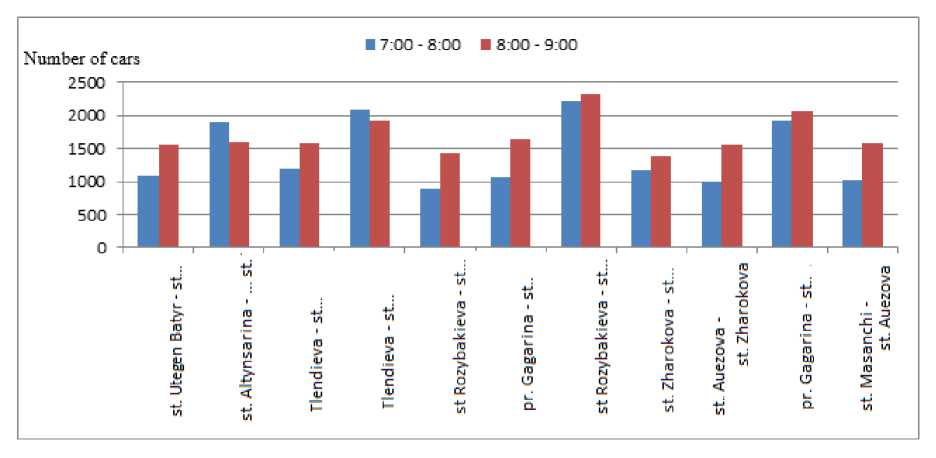
Figure 1 - Distribution of transport Flow through Abay Ave. intersections
Table 1- Ratio of passenger and public transports on Abay Ave.
|
Stage(from – to) |
Time |
Automobile transport, pieces |
Micro bus |
Bus of average capacity |
High-capa city bus |
Trolls beads |
ratio |
|
Furmanov Str. – Dostyk Str. |
7:00 -8:00 |
320 |
11 |
2 |
38 |
0 |
0,16 |
|
Dostyk Str. – Furmanov Str. |
7:00 -8:00 |
245 |
6 |
0 |
32 |
0 |
0,155 |
|
Baytursynov Str. – Seifulina Str. |
7:00 -8:00 |
1195 |
35 |
6 |
67 |
0 |
0,085 |
|
Turgut Ozal Str. – Rozybakiev Str. |
7:00 -8:00 |
1969 |
22 |
1 |
57 |
23 |
0,05 |
|
Rozybakiev Str. – Gagarin Str. |
8:00 -9:00 |
2037 |
29 |
3 |
47 |
27 |
0,05 |
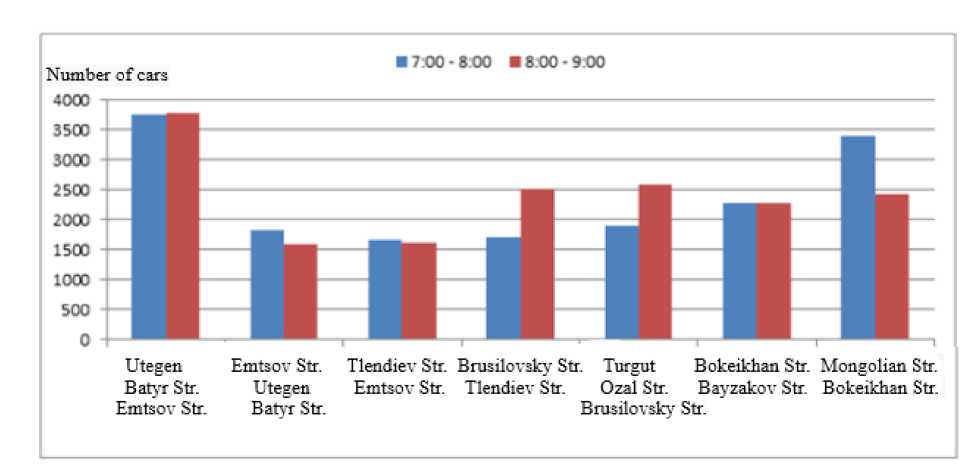
Figure 2 – Distribution of transport Flow through intersections, Rayymbek Ave.
Table 2 – Relations between passenger and public transports by Rayymbek Ave.
|
Stage (from – to) |
Time |
Automobile transport |
Microbus |
Bus of average capacity |
High-capacity bus |
Trolls beads |
|
Turgut Ozal Str. – Brusilovsky Str. |
7:00 - 8:00 |
1455 |
66 |
7 |
87 |
0,11 |
|
Tlendiev Str. – Emtsov Str. |
7:00 - 8:00 |
1652 |
51 |
6 |
67 |
0,082 |
|
Rozybakiev Str. – Bayzakov Str. |
7:00 - 8:00 |
2996 |
83 |
13 |
69 |
0,055 |
|
Mongolian Str. – Bokeikhan Str. |
7:00 - 8:00 |
3365 |
97 |
12 |
73 |
0,098 |
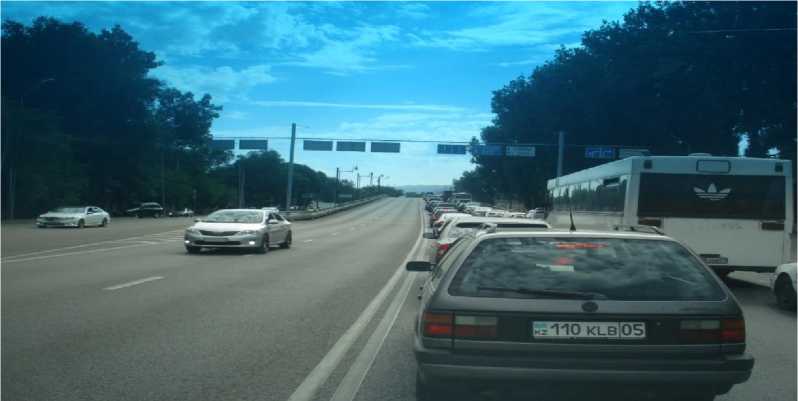
Figure 3 –Rayymbek Ave., 13 June 2019 time 13.52.
Congestion in front of the bridge on the other Seyfullin Ave.
In principle the intensity of the movement of city traffic flow within a day change extremely not evenly. The nature of its change depends on day of the week of carrying out observations. The analysis of data of intensity and the structure of the movement has shown that unlike earlier obtained data with the bimodal law of change of the movement within a day sharp jumps of intensity are not observed. During the day smooth increase in intensity of the movement is noted from 7 to 9 h that is explained by departure of cars to the line at the beginning of the working day. From 9:00 till 17:00 the intensity of the movement practically does not change. Further there is its recession.
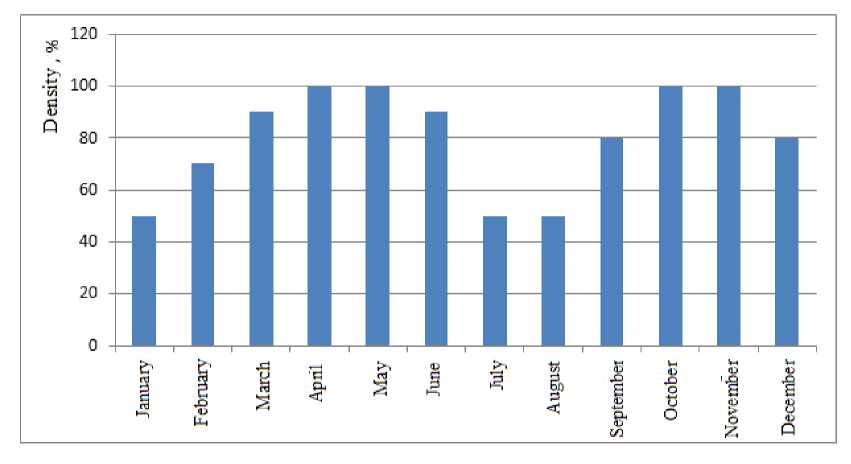
Figure 4 – Pattern of Change of Intensity of Traffic within a year
The second moment concerning the organizations of repair work on the main and trunk streets of Almaty, we consider that contract organizations leaders corresponding digging and the installation and construction works which are blocking off the traffic on this section of the street to oblige conducting work and on the weekend.
Unlike data of 2000 – 2010 change of intensity of the movement during the seasons of year has more dynamic character (Fig. 4). At least it falls on July-August of months, characterized by reduction of intensity of traffic flow in connection with departure of people on rest and end of academic year in educational institutions of the city [7].
Intensity of traffic changes within year as since July 1 the period of holidays begins, in – all higher education institutions and educational institutions are finished academic year and students leave for practice; thus, firmness of traffic flow sharply decreases and increases the throughput speed of the main streets of Almaty.
Conclusion. The difficulties connected with the admission of traffic flows of high intensity are aggravated with large number of pedestrian streamswhich organization of the movement causes much bigger difficulties, than the movement of cars. Proximity of pedestrians-treamsto automobile and combination of their movement on one street are some of the main reasons for road traffic accidents in cities.
These difficulties in the modern city are resolved two in the ways: the organization of the movement on the existing system of streets and reconstruction of the network allowing dividing traffic flows by their function, to separate pedestrians from car traffic and to provide the high capacity of the street.
The serious problem mentioning fundamentals of town planning is represented by need of seating and storage of cars for the city. Required area for auto mobilization of 100 buses at 1000 inhabitants (that there is almost twice less design value) exceeds the area of the housing 5-storey estate. Solution of this problem – creation in residential districts, near the administrative cultural centers and sport centers of the special areas and multistoried garages for short-term and long-term storage of cars. In respect of the organization of the movement the satisfaction of needs for parking’s is necessary as well as ensuring capacity of streets.
Список литературы Problems of urban traffic organizations in a large city of the Republic of Kazakhstan (on the example of Almaty)
- Analiticheskoe agenstvo "Autostat". Access mode: [http://www.autostat.ru/ news/view/10465/], Date of application: 10.07.19. [In Russian]
- Vladykin А.А., Chursina U.А. Finansovyi analyz kak instrument effektivnogo upravlenya biznes-processami v khosyastvushikhsubektakh// Internet-journal "Naukavedenie", 2014. -№ 2. Рр. 17-18. Date of application: 16.07.19. [In Russian]
- Analitichesky otchet proekta PROON/GEF "Ustoichivy transport goroda Almaty". Energoeffektivnost transportnogo sektora Respubliky Kazakhstan sostoenie i mery ee povyshenya, NOTS: Zelenaya Akademiya. Аlmaty: 2015. - 52 р. [In Russian]
- Burkov V.N., Korgin N.А., Nobikov D.А. Vvedenie v teoriue upravlenya organizazhinnym i sistemami/ pod.red.chl.-korr. RAND. А. Novikova. - М.: Limrpkom, 2009. - 264 р. [In Russian]
- Cuzinov Dr.A. Novy tip peresechenii v odnom urovne s nepreryvnym transportnym potokom po glavnoi iz peresekaushikhsya dorog/ Internet-resurs.-Regim dostypa: http://www.2dxt/ de/contru.html. 17.08.19. [In Russian]
- Kopylov G. А. Razrabotka osnov automotizirovannoi sistemy sboai obrabotki informazii o dvigenii transportnykh potokov po automobilnym dorogam// TrudyMADI. -М., 1972. -Вып. 44. - Рр. 60 - 67. [In Russian]
- Otchet ТОО NII travsporta b kommunikazii. 2017. [In Russian]

